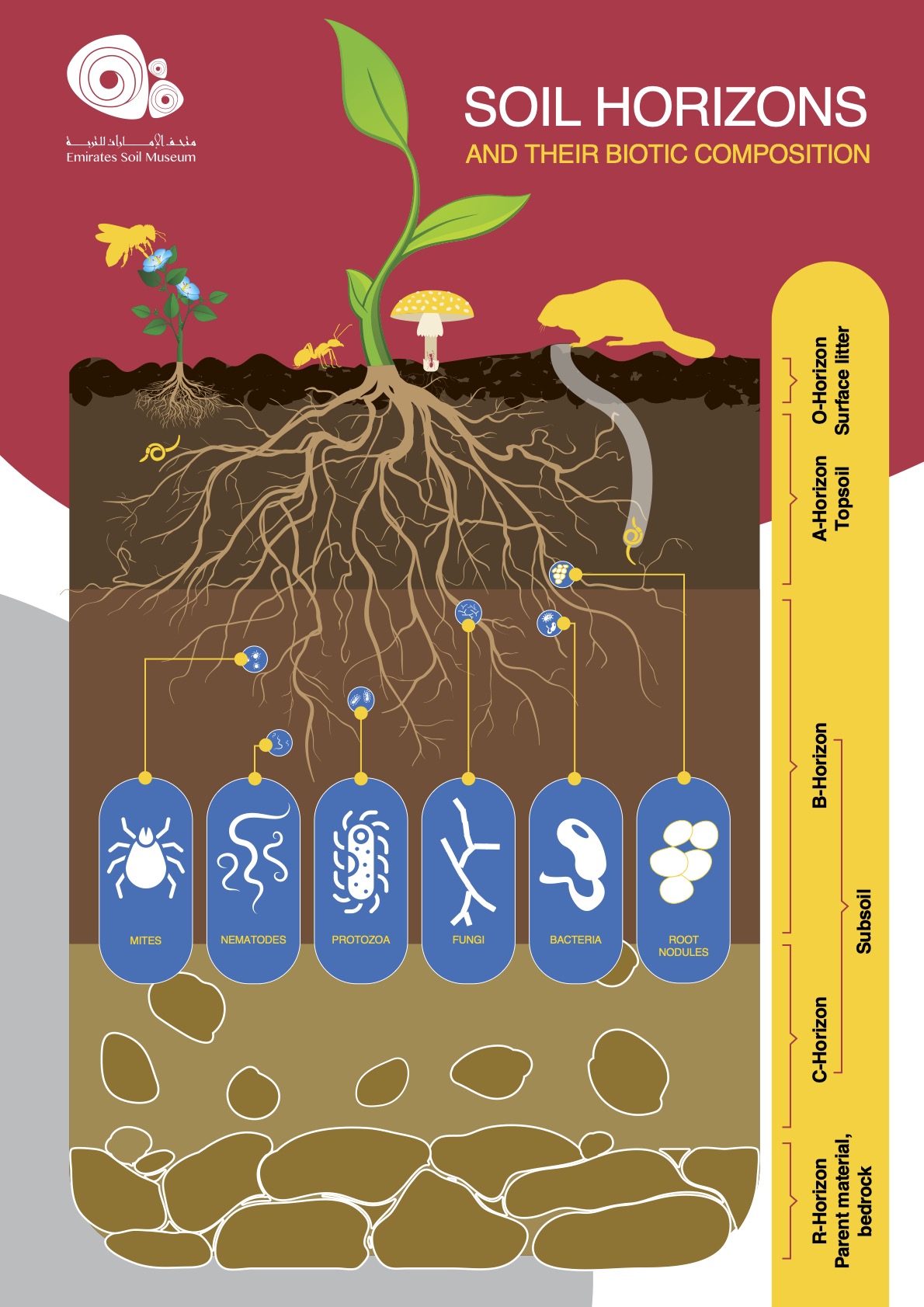The living communities of the soil
From minuscule microbes to much larger animals, soils are a major reservoir of global biodiversity. Indeed, soils are amongst the most biologically rich habitats on Earth, with greater biodiversity per unit area than that observed aboveground. Soil organisms are not mere inhabitants of the soil but rather part of it, heavily influencing all of its properties. The soil biota includes micro-organisms (e.g., bacteria, fungi, protozoa and nematodes), meso-fauna (e.g., mites and springtails) and macro-fauna (e.g., earthworms and termites). Plant roots and some relatively large mammals (for instance, moles, shrews, mice, gophers and prairie dogs) are also part of the soil biodiversity and undergo uncountable interactions with other soil elements.
FUN FACT: There are more organisms in a handful of healthy soil than there are people on the planet.
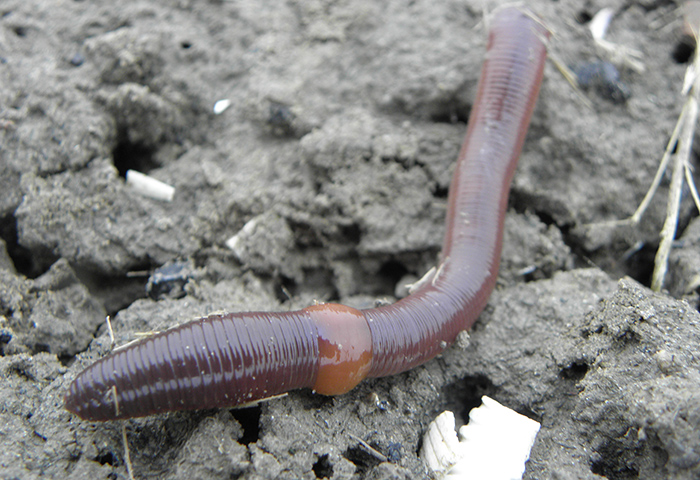
Earthworms
Diversity in soil: 10-15 per ha
Abundance in soil: 300 per m2
Classification: Macro/megafauna
Lumbricus terrestris. Image credit: Rob Hille (https://eol.org/pages/3126801/media?page=7)
Earthworms are annelid invertebrates that play a major role in litter decomposition, nitrogen mineralization and water infiltration, as a result of their feeding and burrowing habits. Hence, they contribute largely to soil nutrient recycling. Earthworms occur in most temperate soils and many tropical soils. There are over 7,000 species of earthworms. Earthworms range from 10 mm to 3 m long and can be found in all depths of soil. Earthworms dominate the world of soil invertebrates in terms of biomass and overall activity. Earthworms are hermaphrodites: each carries male and female sex organs.
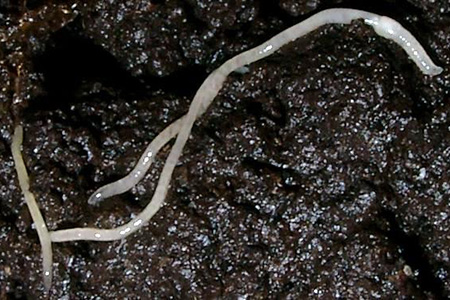
Enchytraeid worms
Diversity in soil: 1-15 per ha
Abundance in soil: 12-311 x 103 per m2
Classification: Mesofauna
Enchytraeus albidus. Image credit: Paul Bachhausen, 2009 (http://www.salamanderseiten.de/weitere/Futtertiere/Enchytraen.htm)
The Enchytraeidae are a very common group of normally unpigmented terrestrial oligochaeta, commonly known as pot worms. These organisms are often spotted in the moist compost when gardeners are transplanting plants to bigger pots.
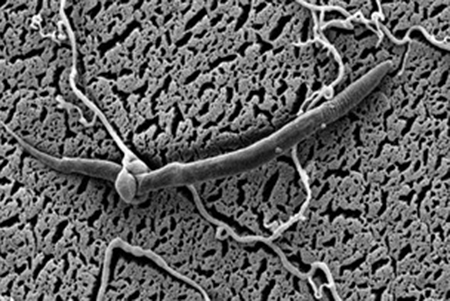
Fungi
Diversity in soil: 200-235 per gram
Abundance in soil: 100 per miligram
Classification: Microorganisms
Drechslerella stenobrocha (forming a constricting ring and trapping a nematode). Image credit: Liu et al (2014) BMC Genomics (https://bmcgenomics.biomedcentral.com/articles/10.1186/1471-2164-15-114)
Fungi are well adapted and important inhabitants of the soil due to their high level of plasticity and ability to adopt various forms in response to the varying soil environment. Fungi can produce a wide variety of extracellular enzymes, allowing them to break down various types of organic matter (in particular certain recalcitrant plant-derived materials), which is crucial for the regulation of carbon and nutrient balances. Soil fungi can behave as biological controllers (they regulate diseases, pests, and the growth of other organisms), ecosystem regulators (being involved in soil structure formation and modification) and organic matter decomposers and compound transformers (as they feed on decaying organic matter and return nutrients to the soil for other organisms in the soil food web to use).
Strength in numbers. Scientists believe that there are around 3 million fungal species in all habitats of the planet, rendering fungi as the most diverse of the domains of life!
Interesting fact: Nematode-trapping fungi are a group of specialized microbial predators which inhabit the soil and that, in circumstances of food scarcity, rely on making traps or trap-related devices to catch and kill nematodes. Research is underway to evaluate the potential of these organisms as biological treatments of crops under the attack of plant-parasitic nematodes. The most widely studied species of nematode-trapping fungi is called Arthrobotrys oligospora. Another species in this group, Drechslerella stenobrocha, demonstrates predatory activity by producing constricting rings to trap and catch nematodes.
Underground networking
Mycorrhizal networks are underground hyphal networks that connect individual plants together and transfer water, carbon, phosphorus, nitrogen, and other compounds. This allows plants growing under conditions of relatively high resource availability (e.g. high-light or high-nitrogen environments) to transfer carbon or nutrients to plants located in less favorable conditions. Mycorrhizal fungi connect not just individuals of the same species but plants of different species. The arbuscular mycorrhizal fungi (fungi of the phylum Glomeromycota) are one of the fungal groups involved in this ‘underground social network’. Arbuscular mycorrhizal fungi actually penetrate the cortical cells of the roots of vascular plants, forming arbuscules.
Did you know? Orchids require to undergo on a symbiotic relationship with mycorrhizal fungi during initial stages of growth. Without it, orchids will not germinate and live.
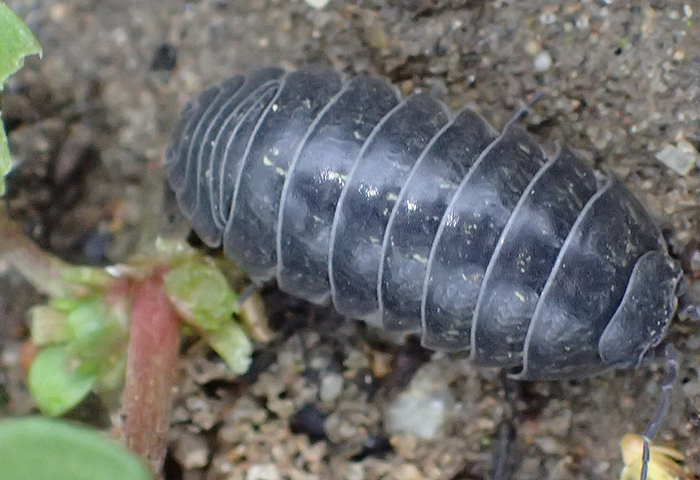
Isopoda
Diversity in soil: 10-100 per m2
Abundance in soil: 10 per m2
Classification: Macrofauna
Armadillidium vulgare. Image credit: Ron Matsumoto (https://eol.org/pages/1021952/media)
The isopoda group includes various crustaceans such as woodlice (e.g., pillbugs). These organisms possess a rigid and segmented exoskeleton, two pairs of antennae, seven pairs of jointed limbs on the thorax, and five pairs of branching appendages on the abdomen. Terrestrial isopods play an important role in many tropical and temperate ecosystems by aiding in the decomposition of plant matter through mechanical and chemical means, in turn enhancing and providing resources for the activity of microbes. Many species can roll themselves into a ball, a behavior mechanism that helps conserving moisture.
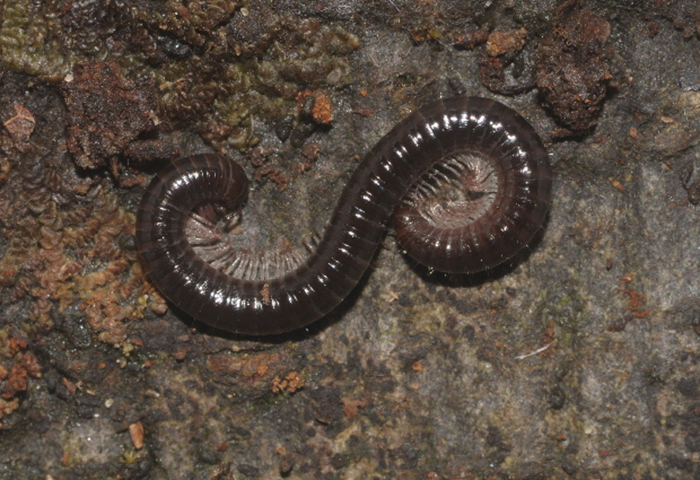
Millipede
Diversity in soil: 10-2,500 per m2
Abundance in soil: 110 per m2
Classification: Macrofauna
Julus scandinavius. Image credit: Joerg Spelda, SNSB Zoologische Staatssammlung Muenchen, 2010 (https://eol.org/pages/314091/media)
Millipedes are a group of widely distributed saprophagous arthropods that consume dead plant litter in temperate and tropical forests. Millipedes are major consumers of fallen leaf litter, and are found abundantly in calcium-rich, moist habitats. Millipedes are important reservoirs of calcium in the soil, as their exoskeleton contains a high amount of this ion. This reflects their importance for calcium cycling. Millipedes can also inhabit arid and semiarid regions, despite their dependence on moisture – in fact, millipedes lack a waxy layer on their epicuticle and are vulnerable to desiccation. Millipedes are characterized by having two pairs of jointed legs on most body segments (hence belonging to the class Diplopoda). Millipedes can be grouped into: 1) tubular/cylindrical, round-backed forms; 2) flat-backed forms; and 3) pill bug types (roll into a ball). Millipedes range widely in length (usually around 5-20 cm).
Did you know? Millipedes (Diplopoda) look somewhat similar but are only distantly related to centipedes (class Chilopoda), which move rapidly, are venomous, carnivorous, and have only a single pair of legs on each body segment. Centipedes are also soil dwellers.
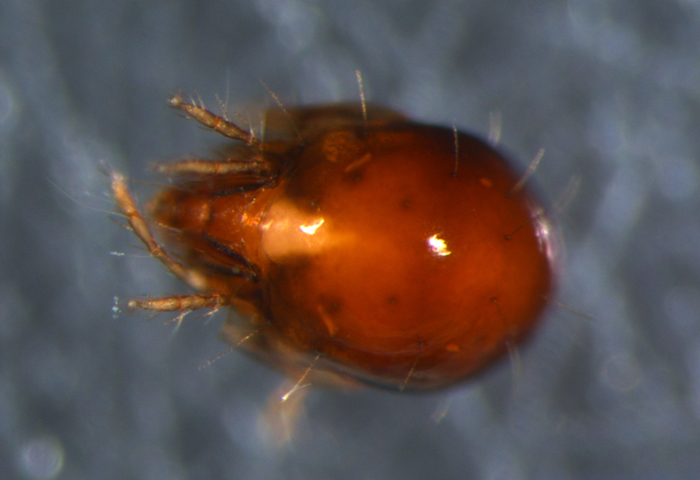
Mites
Diversity in soil: 100-150 per m2
Abundance in soil: 1-10 x 104 per m2
Classification: Mesofauna
Diapterobates notatus. Image credit: Monica Young, Centre for Biodiversity Genomics, 2011 (https://eol.org/pages/1158305/media)
The name ‘mites’ includes species of several groups within the subclass Acari of the class Arachnida (hence, mites are related to spiders). Mites are small arthropods with less than 1 mm in length that have a simple body plan (with a mouth and body proper). Evidence exists suggesting that mites have existed since approximately 500 million years ago. The oribatid mites are the most often found mites of the soil and normally feed on fungi or decaying organic matter. Some mites are predators and consume nematodes, springtails, other mites and insect eggs. Mites contribute to the dynamics of the soil by breaking down organic matter.
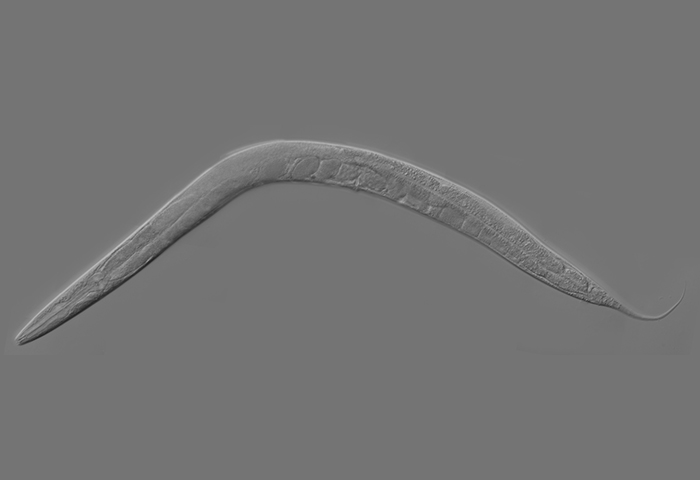
Nematodes
Diversity in soil: 10-100 per m2
Abundance in soil: 2-90 x 105 per m2
Classification: Microfauna
Caenorhabditis elegans. Image credit: Kbradnam, 2006 (https://eol.org/pages/403869/media)
Nematodes are by far the most abundant animals on Earth and represent a major component of the soil community. A recent estimate postulated that 4.4 × 1020 nematodes inhabit surface soils across the world, with higher abundances in sub-Arctic regions (38% of the total) than in temperate (24%) or tropical (21%) regions. This abundance corresponds to a total biomass of approximately 0.3 gigatonnes! Nematodes are microscopic and live in water-filled spaces in the soil. This occurs more frequently in the upper layers of the soil as that is where many of the resources that are used by these animals are most abundant. Nematodes do not decompose organic matter, but, rather, they have a parasitic and free-living lifestyle; in other words, nematodes feed on living material. Nematodes play important roles in the soil as bacterial population regulators, as nitrogen mineralizers and they also influence the composition of soil communities.
Interesting fact: Caenorhabditis elegans is a soil nematode that went on to become one of the most important and widely used model species for genetics and cell biology research. Amongst many other contributions, it was thanks to C. elegans that the scientific community learned about the molecular pathways involved in programmed cell death.
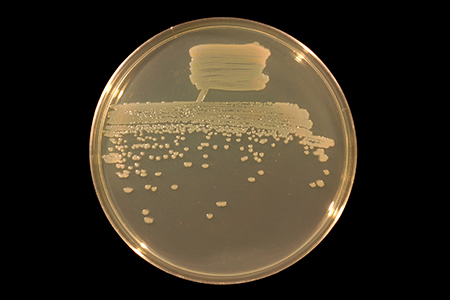
Prokaryotes
Diversity in soil: 100-9,000 per cm3
Abundance in soil: 4-20 x 109 per cm3
Classification: Microorganisms
Pseudomonas fluorescens. Image credit: Ninjatacoshell, 2010 (https://eol.org/pages/973024/media)
Prokaryotes include microbes from the Bacteria and Archaea domains of life. There are more than 1030 (that’s 1,000,000,000,000,000,000,000,000,000,000!) prokaryotes on Earth, of which approximately 2.5 x 1029 cells are present in the soil. Prokaryotes are distinguished from higher organisms due to the absence of a membrane-bound nucleus and because they reproduce exclusively asexually.
Fun fact: Actinomycetes are bacteria that can be found in a variety of habitats across the world, usually in warm and damp soil. After long periods of dry weather, the activities of actinomycetes in soil slow down. Just before the rain, as the soils become damp, actinomycetes start to awake and create a byproduct called geosmin which contributes to the "earthy smell".
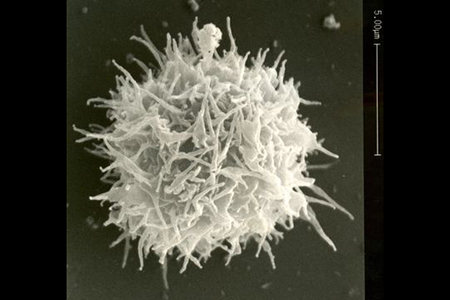
Protists
Diversity in soil: 600-4,800 per gram
Abundance in soil: 104-107 per m2
Classification: Microorganisms
Acanthamoeba castellanii. Image credit: Katz Lab, Flickr (https://eol.org/pages/491172/media)
Protozoa are single-celled organisms that feed mainly on bacteria, but may also eat other protozoa, soluble organic matter, and some fungi. Protozoa play various roles in the soil ecosystem: nutrient mineralization (making them available to be used by plants and other soil organisms), regulation of bacterial populations (by eating them), disease suppression (by competing with or feeding on pathogens), and finally as a food source for other soil organisms. Protozoa are classified into three groups based on their shape: 1) ciliates, the largest protozoa, that move by means of hair-like cilia; 2) amoebae, that move by means of a temporary foot or “pseudopod”; and 3) flagellates, the smallest of the protozoa, that use a few whip-like flagella to move.
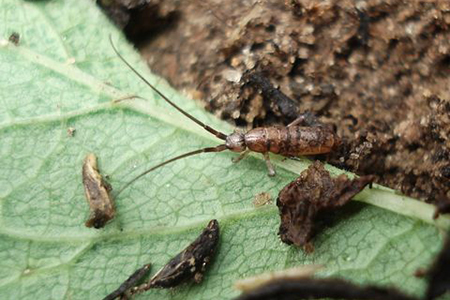
Springtails
Diversity in soil: 20 per m2
Abundance in soil: 1-5 x 104 per m2
Classification: Mesofauna
Pogonognathellus longicornis. Image credit: Sanja565658, 2008 (https://eol.org/media/7763529)
Springtails (or Collembola) are omnivorous, free-living arthropods that usually measure less than 6 mm in length, and that prefer moist conditions. Springtails do not directly decompose the organic matter in the soil, but they do contribute to the process indirectly by fragmenting it. Furthermore, springtails regulate of the populations of soil microbes which are part of their diet. Springtails resemble insects but are not insects because they do not possess wings and have soft bodies and hidden mouthparts.
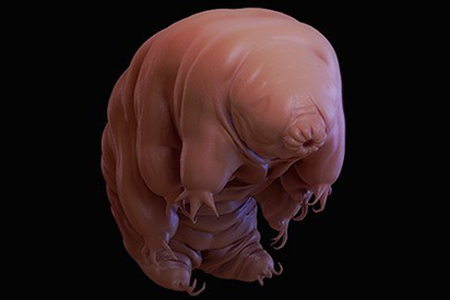
Tardigrades
Diversity in soil: yet to be determined in detail
Abundance in soil: yet to be determined in detail
Classification: Micro/mesofauna
Milnesium tardigradum. Image credit: Schokraie et al, 2006 (https://elifesciences.org/digests/47682/how-tardigrades-survive-the-extreme)
Tardigrades belong to a phylum of microscopic animals popularly called “water bears” that are known for being extraordinarily tough, withstanding periods of extreme drought and cold. They are found particularly associated with lichens, mosses, liverworts and rosette angiosperms, and eat bacteria, plants, and other microscopic organisms. Their ability to enter cryptobiosis (an anabiotic or reversibly suspended metabolic state) enables them to survive extreme environmental conditions. There are some 1,500 species of tardigrades known worldwide. Tardigrades range from 0.1 mm to 1.7 mm, the largest adult, and are bilaterally symmetrical with four pairs of legs, equipped with claws on the distal end, of various sizes and forms. They move very slowly (hence the name meaning, “slow stepper”).
Wow! Tardigrades are the toughest animals on the planet, able to withstand a dose of 5000 grays of gamma radiation (a human withstands 4-10 grays), temperatures ranging from 151°C to less than -200°C, and can live for 200 years.
